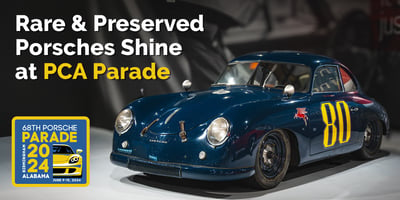Was the 1978-1983 Porsche 911SC the best car to ever wear the 911 badge? It’s a bold question to...
Porsche’s Secret Weapon

Every Porsche is special, and in comparison to everyday cars every Porsche is rare, but die-hard connoisseurs of the brand know that some Stuttgart products are rarer, and more special, than others. In many cases, the prices of these top-drawer Porsches have soared beyond the reach of most – but there is one very special, relatively rare, and historically critical model out there that can often be had for the price of a new economy car: the “928S3” sold in the United States for the 1985 and 1986 model years.

When Porsche introduced the 928, it was just the second time the firm had engineered a clean-sheet design with the intention of selling it under their own name. The 911 had been all-new, but the cars that preceded it had drawn heavily on Volkswagen for engineering and parts, while the lower-priced 914 and 924 had always intended to be sold in cooperation with VW, using that company’s engines. This wasn’t the case with the 928, intended from the start to carry the Porsche name into the 1980s while significantly increasing the firm’s prestige along the way.
In every metric that counted, the 928 was a revolution. Intended to rule the Autobahn while offering luxury-car comfort to its occupants, it abandoned the rear-mounted, Boxer-style engines of previous Porsches for a massive V-8 located between the front axle and the dashboard. The instrument panel adjusted with the steering wheel, to provide perfect visibility to a wide range of drivers. Prospect owners could choose among a variety of interior fabrics and leathers, from the avant-garde to the conventionally upscale.
It looked like a spaceship and drove like one, too, but American customers for the original 928 had to contend with some disappointment in the engine department. Euro buyers could choose from standard-spec 4.5-liter or “S” 4.7-liter V-8s, developing 240 and 300 horsepower respectively, but “smogged” American cars made just 222 horses from 4.5 liters. This was still a lot of power for the era, but by 1980 it was obvious to everyone that the horsepower hostilities would shortly resume. To preserve the 928’s supremacy against Corvettes, Ferraris, and its own 911, Porsche cooked up something special. Even better, this time the United States (and Japan) would get it first.

The 1985 928S didn’t look that different, but opening the long, rectangular hood greeted the new owner with “V8 4C 32V” on the intake manifold. That meant quad cams and 32 valves against the original 928’s two-cam, 16-valve engine. Not obvious, but just as important: displacement was bumped to 302 cubic inches, which any Ford fancier can tell you is basically a “5.0”. This new engine could rev, and it could make power everywhere: 288 horsepower, to be precise.
Car and Driver ran the quarter mile in 14.0s at 102mph, against 14.7s at 94mph for the 1984 model. Top speed soared to 154mph. You’d have needed to buy a Testarossa in order to go any faster. Any other manufacturer of the era would have trumpeted the changes with bodywork, stickers, or at least a badge on the rear deck, but Porsche was content to let this massive increase in capability go basically undeclared.

The European 16-valve, 4.7-liter 928S was making 310 horsepower by then, so Porsche left it alone for 1985. The 32-valve engine was an option in most other markets for 1986. The following year, Porsche performed a global unification of the 928 with the new 928S4 model. It featured new front and rear fascia to go with an uprated, 316-horse version of the 1985 engine, which was then known as “S3” in retrospect. The bodywork changes were simple but highly impactful, making the original 928 look staid and dated in comparison.
The popularity of the S4 model, together with the considerable expense of servicing and maintaining any 928, caused a dramatic dip in 1985-1986 values. Not until the final 928GT was out of showrooms did the cognoscenti regain their fondness for the original Tony Lapine styling of the pre-1987 models. As the finest and fastest of those, the 32-valve 1985 and 1986 cars have experienced some significant appreciation on the market. All of this is relative, however, and it’s still possible to buy a great “S3” for less than what you’d expect to pay for a poor-condition 911SC or Carrera 3.2.
If you do, you’ll immediately see why the 928 was considered such a revolution in its day. No car before or since has had a cockpit quite like this one. The “fishbowl” visibility and mail-slot sunroof can’t really be found in any other Porsche. The driving position is more supercar than 911. Every aspect of the car is clearly optimized for travel at 150mph and beyond.

Happily, many 928s from that era were specified in interesting and exotic colors both inside and out, although if you really want a silver or Guards Red example they’re certainly out there. Rust is rarely an issue with these fully galvanized vehicles, but they are hand built cars that were basically shrink-wrapped around an engineering package of unprecedented complexity. For that reason, it’s important to buy the best example you can afford up front, and to stay ahead of maintenance and repair.
After years of dismissing the car for being the wrong shape and having the engine in the wrong place, Porsche enthusiasts have finally come to love and value the 928. It doesn’t hurt that many of the firm’s more recent vehicles, like the Panamera, have also been front-engine V-8 cars. If you’re interested in owning a car that represents Porsche’s maximum capabilities, designed, and built with little regard for cost or the desires of the average driver, the 1985-1986 928 might be the perfect, and very special, choice.




